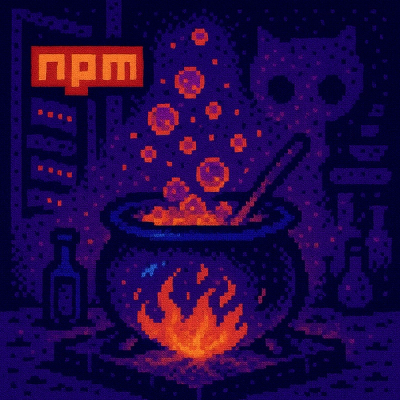
Security News
The Changelog Podcast: Practical Steps to Stay Safe on npm
Learn the essential steps every developer should take to stay secure on npm and reduce exposure to supply chain attacks.

Straightforward HTML parser for JavaScript. Live Demo.
npm install hyntax
const { tokenize, constructTree } = require('hyntax')
const util = require('util')
const inputHTML = `
<html>
<body>
<input type="text" placeholder="Don't type">
<button>Don't press</button>
</body>
</html>
`
const { tokens } = tokenize(inputHTML)
const { ast } = constructTree(tokens)
console.log(JSON.stringify(tokens, null, 2))
console.log(util.inspect(ast, { showHidden: false, depth: null }))
Hyntax is written in JavaScript but has integrated TypeScript typings to help you navigate around its data structures. There is also Types Reference which covers most common types.
Use StreamTokenizer and StreamTreeConstructor classes to parse HTML chunk by chunk while it's still being loaded from the network or read from the disk.
const { StreamTokenizer, StreamTreeConstructor } = require('hyntax')
const http = require('http')
const util = require('util')
http.get('http://info.cern.ch', (res) => {
const streamTokenizer = new StreamTokenizer()
const streamTreeConstructor = new StreamTreeConstructor()
let resultTokens = []
let resultAst
res.pipe(streamTokenizer).pipe(streamTreeConstructor)
streamTokenizer
.on('data', (tokens) => {
resultTokens = resultTokens.concat(tokens)
})
.on('end', () => {
console.log(JSON.stringify(resultTokens, null, 2))
})
streamTreeConstructor
.on('data', (ast) => {
resultAst = ast
})
.on('end', () => {
console.log(util.inspect(resultAst, { showHidden: false, depth: null }))
})
}).on('error', (err) => {
throw err;
})
Here are all kinds of tokens which Hyntax will extract out of HTML string.

Each token conforms to Tokenizer.Token interface.
Resulting syntax tree will have at least one top-level Document Node with optional children nodes nested within.
{
nodeType: TreeConstructor.NodeTypes.Document,
content: {
children: [
{
nodeType: TreeConstructor.NodeTypes.AnyNodeType,
content: {…}
},
{
nodeType: TreeConstructor.NodeTypes.AnyNodeType,
content: {…}
}
]
}
}
Content of each node is specific to node's type, all of them are described in AST Node Types reference.
Hyntax has its tokenizer as a separate module. You can use generated tokens on their own or pass them further to a tree constructor to build an AST.
tokenize(html: String): Tokenizer.Result
htmlAfter you've got an array of tokens, you can pass them into tree constructor to build an AST.
constructTree(tokens: Tokenizer.AnyToken[]): TreeConstructor.Result
tokensinterface Result {
state: Tokenizer.State
tokens: Tokenizer.AnyToken[]
}
statetokensinterface Result {
state: State
ast: AST
}
state
The current state of the tree constructor. Can be persisted and passed to the next tree constructor call in case when tokens are coming in chunks.
ast
Resulting AST.
Type: TreeConstructor.AST
Generic Token, other interfaces use it to create a specific Token type.
interface Token<T extends TokenTypes.AnyTokenType> {
type: T
content: string
startPosition: number
endPosition: number
}
type
One of the Token types.
content
Piece of original HTML string which was recognized as a token.
startPosition
Index of a character in the input HTML string where the token starts.
endPosition
Index of a character in the input HTML string where the token ends.
Shortcut type of all possible tokens.
type AnyTokenType =
| Text
| OpenTagStart
| AttributeKey
| AttributeAssigment
| AttributeValueWrapperStart
| AttributeValue
| AttributeValueWrapperEnd
| OpenTagEnd
| CloseTag
| OpenTagStartScript
| ScriptTagContent
| OpenTagEndScript
| CloseTagScript
| OpenTagStartStyle
| StyleTagContent
| OpenTagEndStyle
| CloseTagStyle
| DoctypeStart
| DoctypeEnd
| DoctypeAttributeWrapperStart
| DoctypeAttribute
| DoctypeAttributeWrapperEnd
| CommentStart
| CommentContent
| CommentEnd
Shortcut to reference any possible token.
type AnyToken = Token<TokenTypes.AnyTokenType>
Just an alias to DocumentNode. AST always has one top-level DocumentNode. See AST Node Types
type AST = TreeConstructor.DocumentNode
There are 7 possible types of Node. Each type has a specific content.
type DocumentNode = Node<NodeTypes.Document, NodeContents.Document>
type DoctypeNode = Node<NodeTypes.Doctype, NodeContents.Doctype>
type TextNode = Node<NodeTypes.Text, NodeContents.Text>
type TagNode = Node<NodeTypes.Tag, NodeContents.Tag>
type CommentNode = Node<NodeTypes.Comment, NodeContents.Comment>
type ScriptNode = Node<NodeTypes.Script, NodeContents.Script>
type StyleNode = Node<NodeTypes.Style, NodeContents.Style>
Interfaces for each content type:
Generic Node, other interfaces use it to create specific Nodes by providing type of Node and type of the content inside the Node.
interface Node<T extends NodeTypes.AnyNodeType, C extends NodeContents.AnyNodeContent> {
nodeType: T
content: C
}
Shortcut type of all possible Node types.
type AnyNodeType =
| Document
| Doctype
| Tag
| Text
| Comment
| Script
| Style
Shortcut type of all possible types of content inside a Node.
type AnyNodeContent =
| Document
| Doctype
| Text
| Tag
| Comment
| Script
| Style
interface Document {
children: AnyNode[]
}
interface Doctype {
start: Tokenizer.Token<Tokenizer.TokenTypes.DoctypeStart>
attributes?: DoctypeAttribute[]
end: Tokenizer.Token<Tokenizer.TokenTypes.DoctypeEnd>
}
interface Text {
value: Tokenizer.Token<Tokenizer.TokenTypes.Text>
}
interface Tag {
name: string
selfClosing: boolean
openStart: Tokenizer.Token<Tokenizer.TokenTypes.OpenTagStart>
attributes?: TagAttribute[]
openEnd: Tokenizer.Token<Tokenizer.TokenTypes.OpenTagEnd>
children?: AnyNode[]
close: Tokenizer.Token<Tokenizer.TokenTypes.CloseTag>
}
interface Comment {
start: Tokenizer.Token<Tokenizer.TokenTypes.CommentStart>
value: Tokenizer.Token<Tokenizer.TokenTypes.CommentContent>
end: Tokenizer.Token<Tokenizer.TokenTypes.CommentEnd>
}
interface Script {
openStart: Tokenizer.Token<Tokenizer.TokenTypes.OpenTagStartScript>
attributes?: TagAttribute[]
openEnd: Tokenizer.Token<Tokenizer.TokenTypes.OpenTagEndScript>
value: Tokenizer.Token<Tokenizer.TokenTypes.ScriptTagContent>
close: Tokenizer.Token<Tokenizer.TokenTypes.CloseTagScript>
}
interface Style {
openStart: Tokenizer.Token<Tokenizer.TokenTypes.OpenTagStartStyle>,
attributes?: TagAttribute[],
openEnd: Tokenizer.Token<Tokenizer.TokenTypes.OpenTagEndStyle>,
value: Tokenizer.Token<Tokenizer.TokenTypes.StyleTagContent>,
close: Tokenizer.Token<Tokenizer.TokenTypes.CloseTagStyle>
}
interface DoctypeAttribute {
startWrapper?: Tokenizer.Token<Tokenizer.TokenTypes.DoctypeAttributeWrapperStart>,
value: Tokenizer.Token<Tokenizer.TokenTypes.DoctypeAttribute>,
endWrapper?: Tokenizer.Token<Tokenizer.TokenTypes.DoctypeAttributeWrapperEnd>
}
interface TagAttribute {
key?: Tokenizer.Token<Tokenizer.TokenTypes.AttributeKey>,
startWrapper?: Tokenizer.Token<Tokenizer.TokenTypes.AttributeValueWrapperStart>,
value?: Tokenizer.Token<Tokenizer.TokenTypes.AttributeValue>,
endWrapper?: Tokenizer.Token<Tokenizer.TokenTypes.AttributeValueWrapperEnd>
}
FAQs
Straightforward HTML parser for Node.js and browser
The npm package hyntax-yx receives a total of 2,042 weekly downloads. As such, hyntax-yx popularity was classified as popular.
We found that hyntax-yx demonstrated a not healthy version release cadence and project activity because the last version was released a year ago. It has 1 open source maintainer collaborating on the project.
Did you know?

Socket for GitHub automatically highlights issues in each pull request and monitors the health of all your open source dependencies. Discover the contents of your packages and block harmful activity before you install or update your dependencies.

Security News
Learn the essential steps every developer should take to stay secure on npm and reduce exposure to supply chain attacks.

Security News
Experts push back on new claims about AI-driven ransomware, warning that hype and sponsored research are distorting how the threat is understood.

Security News
Ruby's creator Matz assumes control of RubyGems and Bundler repositories while former maintainers agree to step back and transfer all rights to end the dispute.